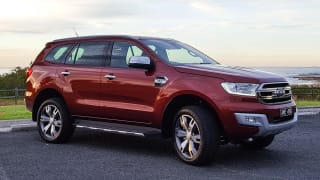
Ford Everest 2017 review
Based on the Ranger pickup truck platform, the Ford Everest launched last year to much fanfare - but is it sufficiently different to warrant its extra cost?
Browse over 9,000 car reviews

The Toyota HiLux is the epitome of an Australian tradie's work vehicle. However, the company has taken the base HiLux and converted it into something quite different.
The Fortuner wagon, based on the HiLux, was released in 2015, and the Crusade model is the top of the tree. Is it worth the extra money over its GX and GXL siblings or will escaping from its commercial roots prove too hard?
| Toyota Fortuner 2018: GX | |
|---|---|
| Safety rating | |
| Engine Type | 2.8L turbo |
| Fuel Type | Diesel |
| Fuel Efficiency | 8.6L/100km |
| Seating | 7 seats |
| Price from | $35,090 |
At $56,990 – the result of a recent $5000 price cut - you can't get any higher in the Fortuner range than the Crusade. Sitting above the GXL, the Crusade offers a few extras on top, including a leather interior with heated front seats and a powered driver’s pew, a JBL-branded multimedia system with 11 speakers, and more satin-touch interior finishes, including around the gearshift.

It competes with the top range Ford Everest Trend at $58,990, the Mitsubishi Pajero Sport Exceed at $53,000, as well as the Isuzu MU-X LS-T at $56,100.
The Fortuner Crusade comes with the same powertrain as the rest of the range; a 2.8-litre four-cylinder turbo-diesel (as fitted to the HiLux), and only available with a six-speed automatic and dual-range 4x4 as standard.

It also comes with a locking rear diff, high-low range 4WD, and a powered tailgate.
We wonder, though, if the extra gear is enough to warrant the jump up to the Crusade from an automatic GXL, which costs less than $50,000 for the same mechanical spec.

The genre of 4x4 wagons runs the design gamut from the underdone and straight-laced Isuzu MU-X, all the way through to the unorthodox Mitsubishi Pajero Sport.
The Fortuner slots in somewhere between the two extremes. It's certainly not something you'd mistake for a Prado, sure, but it's not quite as challenging as something like the Pajero Sport.

The LED headlight array and extra chrome may not appeal to some, but as a package, the Fortuner looks futuristic but resolved, as well.
Inside' it manages to hide its commercial origins quite well. However, there are still some hard plastics within view, including on top of the door cards, which can be a little bit irritating should you rest your elbow there on longer trips.

Thankfully, we can report the centre console bin lid is padded in the Crusade. Cheaper versions of the Fortuner have seen us actually sticky tape pieces of foam mat on top of the lid to find extra comfort.
The Crusade is little different to the GXL that it sits above, aside from a higher level of interior trim. This means comfortable, supportive front seats with the added attraction of heaters… which incidentally don't actually heat that much.
There is a JBL stereo system with more speakers, but unfortunately the dash-mounted speakers have a bright silver trim edge that reflects directly into the window screen. They really need to be satin black in order to disappear from view.
The multimedia system is fully featured, with a Bluetooth-streaming digital radio, but no Apple CarPlay or Android Auto support. The lack of a conventional volume dial is irritating, as well.
The Crusade is also fitted with a third row of seats, mounted hard up against the side of the cabin area, which compromises luggage space as well as rear three-quarter visibility.

The jump seats themselves are rather large, but mounted close to the floor, which means adults have their knees around their ears if they try to use them.

Access is via tumble forward second row seats, which also feature ISOFIX mounts, while a centre armrest offers cupholders for backseat passengers.
The second-row riders also have the rare privilege of being able to use a 220-volt power socket as well as a more traditional, cigarette lighter style 12-volt charging point. There are also vents in the roof as well as a rudimentary fan control, but nothing that extends through to the rear row.

Even though it is deemed the more luxurious model, the Crusade still comes standard with deep rubber floor mats that belie its off-road intentions. If you are taking your Fortuner out bush and you have nervous passengers, you'll be gratified to know that all seat points, save for the middle rear, are equipped with grab handles, too.
The exterior is equipped with wide side rails, but they conversely make it awkward to climb up into the car, especially for people of lesser stature. They find themselves having to enter backside first, rather than being able to climb easily onto the running boards.
Other practicalities include excellent quality auto LED headlights, along with LED fog lights.
If you're looking to stash liquids, there are two cupholders up front, two in the centre armrest in the rear, none for the rear row, and bottle holders in all four doors.
The main difference between the Fortuner and the HiLux, beside the lack of a load tray, is the way the rear suspension is laid out. The more load-oriented Hilux uses old-fashioned leaf springs to increase its payload capacity, at the expense of a harsher, bumpier ride, especially with no load aboard.
The Fortuner uses coil springs and a separate damper (or shock) to give the rear-end a more comfortable, car-like ride quality.
Despite its obvious off-road abilities, with its increased ride height, multi-terrain tyres and ground clearance, the Fortuner is actually quite a good road car. There's sufficient sound deadening beneath it to prevent the majority of noise getting back into the cabin, and that softer suspension tune works well with only one or two people aboard.
It can also take four people in comfort, although the second row's seat base is mounted higher, which can restrict headroom for taller passengers. Not a serious issue, but worth noting.
There is enough legroom and toe room behind the front seats for kids, though it can tighten up quickly with four big lads aboard. The third row will easily cope with small children, even on a medium-length trip. Of course it does massively compromise what you can take along on that trip, luggage-wise.
The 2.8 litre turbo-diesel engine is responsive in the low and middle ranges, but can run out of puff if asked to push towards its redline. The gearbox is a great match to the engine, and even though there are steering wheel paddles included, we seldom used them; it all just worked.
The Fortuner is quite a capable off-roader, too. It adds a hill control descent mode, and with the locking rear diff and switchable high and low-range 4x4, it can tackle tough trails easily, although it doesn't have the fuel range of something like its bigger LandCruiser and Prado siblings.
The (1GD-FTV) turbo four-cylinder diesel engine (from the HiLux) produces 130kW at 3400rpm, and 450Nm between 1400 and 2600rpm.

Fitted with a traditional six-speed auto, it’s a relatively quiet and pleasingly smooth engine. There’s also an idle-up switch that works to hold engine revs higher for off-road work.
The Crusade can tow up to 2800kg of braked trailer – it’s a 200kg reduction over the manual, which can’t be had in this grade. With a gross vehicle mass of 2750kg and a weight of 2135kg, there’s 615kg of payload to play with.
Fuel consumption after 795 kilometres of testing reveals a dash indicated figure of 9.7 litres per 100 kilometres. This also included a period with high range 4x4 usage, which does add to that tally.
Toyota claims a figure of 7.8L/100km on the combined fuel economy cycle. Its 80-litre tank gives the Fortuner a theoretical range of just over 1000km.
Basic Warranty
3 years / 100,000 km warranty
ANCAP Safety Rating

With seven airbags (including curtain airbags extending to the third row), a reversing camera and sensors, trailer sway control, as well as stability and traction control, the Fortuner has a top five-star ANCAP score. It does miss out on AEB, adaptive cruise control and lane departure warning, though.
A three year/100,000km warranty is provided as standard. Toyota has a fixed service program for the Fortuner, which costs $240 per service for the first six services over three years or 60,000km.
A service interval of 12 months or 10,000km is suggested.
It is quite an unusual market segment, but the 4x4 wagon does serve a purpose, especially if you need to tow a little more than normal, and if you'd like to take trips off the beaten track in relative comfort.
The Fortuner doesn't make you pay for those abilities by being a poor on-road companion, either. In fact, it's quite the match for any of the larger SUVs in terms of noise suppression and ride quality. It's also reasonably practical for the medium to large family. We’re not convinced about the third row of seats, as they do steal valuable luggage space, and the car's looks will also polarise opinion.
Given the recent price cuts, though, the Fortuner offers a viable alternative to something like the Prado, and sits well in the growing 4x4 wagon space.
| Vehicle | Specs | Price* | |
|---|---|---|---|
| GX | 2.8L, Diesel, 6 SP AUTO | $35,090 – 41,800 | 2018 Toyota Fortuner 2018 GX Pricing and Specs |
| GXL | 2.8L, Diesel, 6 SP AUTO | $39,380 – 46,310 | 2018 Toyota Fortuner 2018 GXL Pricing and Specs |
| Crusade | 2.8L, Diesel, 6 SP AUTO | $45,870 – 53,350 | 2018 Toyota Fortuner 2018 Crusade Pricing and Specs |
| Price and features | 7 |
|---|---|
| Design | 8 |
| Practicality | 7 |
| Driving | 8 |
| Under the bonnet | 7 |
| Efficiency | 7 |
| Safety | 7 |
| Ownership | 8 |
$24,990
Lowest price, based on 102 car listings in the last 6 months